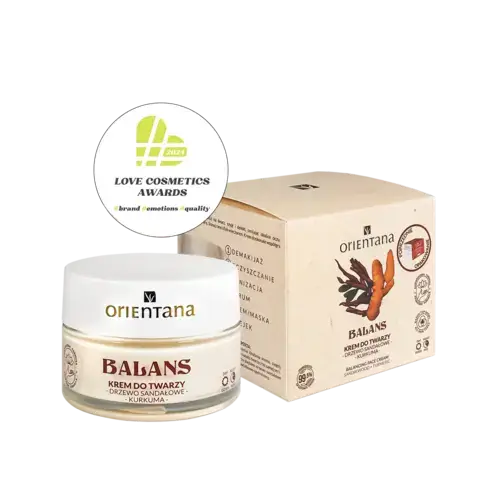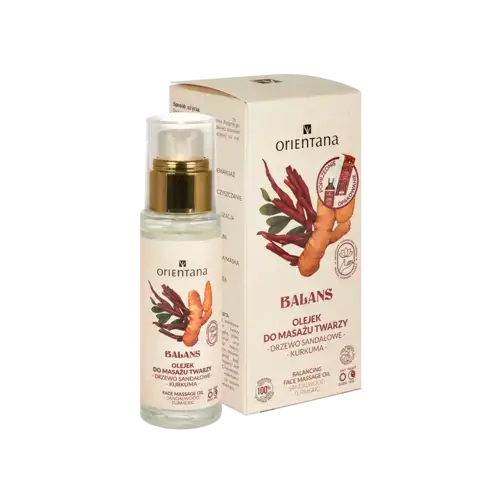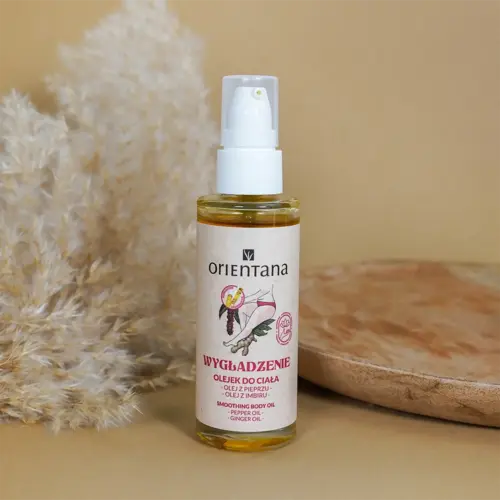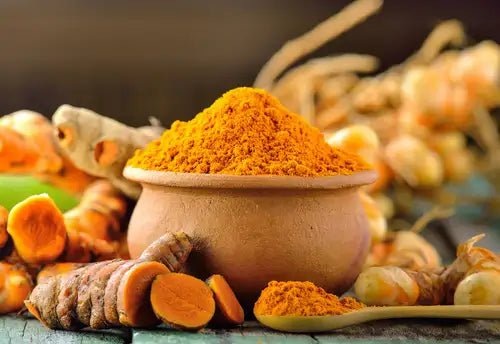Turmeric has been known for centuries as an aromatic spice, especially valued in Indian and Ayurvedic cuisine. Its yellow-orange color and characteristic taste have made it an indispensable element of many dishes. However, this is not the only use of this extraordinary plant.
It is also increasingly being talked about in the context of skin care – and for good reason. Turmeric, or more precisely the curcumin it contains, has a number of properties that make it a valuable ingredient in facial cosmetics.
In recent years, we have observed a dynamic increase in the popularity of turmeric properties in natural cosmetics and dermocosmetics. Consumers are increasingly reaching for products based on plant extracts, which offer effectiveness without burdening the skin with aggressive chemicals.
Turmeric has gained recognition for its anti-inflammatory, soothing and antioxidant effects, which makes it an ally in the care of problematic, sensitive and mature skin.
If you are wondering how turmeric works on facial skin and whether it is worth including it in your daily care routine – this article is for you. Read on to find out what benefits turmeric cosmetics bring and how to best use its potential in your beauty routine.

TURMERIC - Meaning in Ayurveda and scientific perspective on curcumin
Turmeric in Ayurveda – the “golden herb” of health and beauty
Turmeric (Curcuma longa) is a plant from the ginger family, whose root has been used for centuries in traditional medical systems, especially in Ayurveda, the Indian natural medicine. In Sanskrit, turmeric is known by many names, including Haridra , Gauri , and Kanchani , which literally means "gold" - referring to its color and precious properties.
In Ayurveda, turmeric is valued as a tridosha herb, meaning it supports the balance of all three doshas – Vata, Pitta and Kapha. It has been used to cleanse the blood, aid digestion, heal wounds and skin inflammation.
Ayurvedic doctors used turmeric pastes to heal skin lesions, acne, and as an ingredient in rejuvenating and brightening face masks. It was also used in brides' beauty rituals as a symbol of purification and radiance.
Interestingly, the traditional Ayurvedic approach to beauty assumes that external beauty is a reflection of internal health – and turmeric helps restore this harmony.
Curcumin – the key active ingredient of turmeric
Modern science confirms many of the properties that Ayurveda has attributed to turmeric for thousands of years. The most valuable chemical compound contained in turmeric is curcumin , a polyphenol responsible for its intense color and wide spectrum of biological effects.
Science trivia:
Curcumin makes up on average about 2–5% of the dry weight of turmeric root, but it is this small percentage that is responsible for its strong anti-inflammatory, antioxidant and antibacterial effects.
Laboratory studies have shown that curcumin:
- inhibits inflammation by regulating pro-inflammatory cytokines,
- has an antioxidant effect , neutralizing free oxygen radicals and increasing the activity of antioxidant enzymes,
- has antibacterial and antifungal properties , especially useful in the care of acne-prone skin,
- affects the skin healing process by stimulating skin cell proliferation and collagen production,
- Inhibits excessive melanin production , which helps lighten discolorations and even out skin tone.
In cosmetics, curcumin is most often used in the form of turmeric root extract (Curcuma Longa Root Extract) , which is stable and well tolerated by the skin.
In modern formulations, it is often combined with lipid carriers or nanoparticles to increase its bioavailability and effectiveness in the deeper layers of the skin.
Active ingredients of turmeric important in cosmetics
Turmeric is a raw material with an exceptionally rich phytochemical composition, thanks to which it is successfully used in modern facial cosmetics.
The active substances contained in turmeric have a wide spectrum of action: from anti-inflammatory and antibacterial, to antioxidant and regenerative. It is these properties that make turmeric ingredients enjoy growing recognition among dermocosmetics manufacturers, especially in formulas for acne, tired and mature skin.

Curcumin – a polyphenol with multifaceted action
- Curcumin is the most valuable active compound contained in turmeric root, constituting 2 to 5% of its weight.
- It belongs to the group of polyphenols and is responsible for the intense yellow color of the spice. However, its biological properties are much more important than the color.
- Curcumin has a strong anti-inflammatory effect – it inhibits the expression of pro-inflammatory cytokines such as TNF-α, IL-1 and IL-6, which effectively alleviates the symptoms of skin inflammation, including acne and eczema.
- Its antioxidant activity is comparable to vitamin C and E – it neutralizes free radicals and protects skin cells from oxidative stress, which accelerates the aging of the epidermis.
- Curcumin also has the ability to inhibit the enzyme tyrosinase, responsible for the production of melanin. Thanks to this, it has a lightening effect on discolorations and evens out skin tone. Additionally, it supports the healing of minor damage and accelerates the regeneration of the epidermis by stimulating the proliferation of skin cells and the production of collagen.
Turmeric essential oil
- The essential oil obtained from turmeric root contains a number of aromatic compounds such as tumerone, atlantone and zingiberene.
- These ingredients have antibacterial, anti-inflammatory, and antifungal properties. They are also valued for their ability to soothe irritations and support the skin's natural protective barrier.
- In facial cosmetics, turmeric oil is most often used in light care oils, serums or oil-to-milk emulsions.
- Thanks to the content of terpenes and sesquiterpenes, it helps cleanse the skin of toxins, soothes redness and reduces minor imperfections. It can also be used as a natural preservative in natural cosmetics.
Vitamins and minerals that support skin condition
- Turmeric contains natural forms of vitamins and microelements that support physiological processes in the skin. Vitamin C stimulates collagen synthesis, supports healing and lightens discolorations.
- Vitamin E – as a strong antioxidant – protects epidermal lipids from oxidation and prevents loss of skin elasticity.
- Turmeric also provides minerals such as zinc, potassium and iron, which support microcirculation, reduce inflammation and improve the skin's overall resistance to external factors. Thanks to this, cosmetics with turmeric not only act symptomatically, but also support the skin from the inside, strengthening its structure and resistance.
Curcuminoids – pigments with protective action
- In addition to curcumin itself, turmeric contains other curcuminoids, such as demethoxycurcumin and bisdemethoxycurcumin. Although they are present in smaller amounts, their synergistic effect with curcumin enhances the protective and regenerative effect.
- Curcuminoids have a high UV absorption capacity, which makes them natural sunscreens. Their presence in cosmetics helps to reduce skin photoaging, improve firmness and elasticity, and slow down collagen degradation.
Antimicrobial compounds
- Turmeric also contains natural substances with antibacterial and antifungal properties. Turmerone stands out among them, which effectively fights bacteria and yeasts that live on the surface of the skin, such as Staphylococcus aureus or Malassezia furfur . Thanks to this, cosmetics with turmeric are an excellent choice for people with oily, seborrheic skin, as well as for those struggling with acne or eczema.
- Regular use of such products helps reduce the number of blemishes, cleanse pores and restore the balance of the facial skin microbiome.
Flavonoids and tannins – support for blood vessels and astringent effect
- Turmeric also contains smaller amounts of flavonoids and tannins, which strengthen blood vessels, reduce their permeability and prevent redness. They also have a mild astringent and antibacterial effect, which makes them helpful in cleansing the skin of microorganisms and impurities.
- Their presence in cosmetics supports curcumin in soothing inflammation and enhances the toning and normalizing effect of the product.
Regular use of such products helps reduce the number of blemishes, cleanse pores and restore the balance of the facial skin microbiome.
Flavonoids and tannins – support for blood vessels and astringent effect
- Turmeric also contains smaller amounts of flavonoids and tannins, which strengthen blood vessels, reduce their permeability and prevent redness. They also have a mild astringent and antibacterial effect, which makes them helpful in cleansing the skin of microorganisms and impurities.
- Their presence in cosmetics supports curcumin in soothing inflammation and enhances the toning and normalizing effect of the product.
Turmeric Properties and Meaning in Ayurveda + Scientific Look at Curcumin
Turmeric in Ayurveda – the “golden herb” of health and beauty
Turmeric (Curcuma longa) is a plant from the ginger family, whose root has been used for centuries in traditional medical systems, especially in Ayurveda, the Indian natural medicine. In Sanskrit, turmeric is known by many names, including Haridra , Gauri , and Kanchani , which literally means "gold" - referring to its color and precious properties.
In Ayurveda, turmeric is valued as a tridosha herb, meaning it supports the balance of all three doshas – Vata, Pitta and Kapha. It has been used to cleanse the blood, aid digestion, heal wounds and skin inflammation.
Ayurvedic doctors used turmeric pastes to heal skin lesions, acne, and as an ingredient in rejuvenating and brightening face masks. It was also used in brides' beauty rituals as a symbol of purification and radiance.
Interestingly, the traditional Ayurvedic approach to beauty assumes that external beauty is a reflection of internal health – and turmeric helps restore this harmony.
Curcumin – the key active ingredient of turmeric
Modern science confirms many of the properties that Ayurveda has attributed to turmeric for thousands of years. The most valuable chemical compound contained in turmeric is curcumin , a polyphenol responsible for its intense color and wide spectrum of biological effects.
Science trivia:
Curcumin makes up on average about 2–5% of the dry weight of turmeric root, but it is this small percentage that is responsible for its strong anti-inflammatory, antioxidant and antibacterial effects.
Laboratory studies have shown that curcumin:
- inhibits inflammation by regulating pro-inflammatory cytokines (e.g. TNF-α, IL-6),
- has an antioxidant effect , neutralizing free oxygen radicals and increasing the activity of antioxidant enzymes,
- has antibacterial and antifungal properties , especially useful in the care of acne-prone skin,
- affects the skin healing process by stimulating skin cell proliferation and collagen production,
- Inhibits excessive melanin production , which helps lighten discolorations and even out skin tone.
In cosmetics, curcumin is most often used in the form of turmeric root extract (Curcuma Longa Root Extract) , which is stable and well tolerated by the skin.
In modern formulations, it is often combined with lipid carriers or nanoparticles to increase its bioavailability and effectiveness in the deeper layers of the skin.
Who are turmeric cosmetics for?
Turmeric cosmetics are enjoying growing interest not only because of their naturalness, but also because of their wide spectrum of action. Thanks to the presence of curcumin and other bioactive compounds, they can be an effective support in the care of various types of skin - from problematic to mature.
But like any ingredient, turmeric isn’t right for everyone. So it’s worth taking a closer look at who can benefit the most from it and who should be cautious.
Turmeric cosmetics are especially recommended for people struggling with acne and imperfections. Thanks to its anti-inflammatory and antibacterial properties, curcumin effectively soothes redness, reduces the number of pimples and supports pore cleansing.
Additionally, it has a sebostatic effect – it regulates sebum production, which is crucial in the care of oily and combination skin. Regular use of cosmetics with turmeric can help improve the condition of the skin, reduce the formation of inflammatory changes and lighten acne discolorations.
Turmeric has strong soothing properties, making it a suitable ingredient for sensitive skin. It reduces inflammatory reactions, minimizes burning and tightness, and strengthens the skin's natural protective barrier.
It can be used in the care of skin with erythema, hyperreactive skin and in transitional periods when the skin becomes more susceptible to external factors. It is worth remembering, however, that sensitive skin requires tolerance tests - even a natural ingredient such as turmeric can cause an allergic reaction.
Thanks to its strong antioxidant properties, turmeric effectively protects the skin from oxidative stress and helps fight the signs of aging.
Curcumin inhibits the degradation of collagen and elastin, and also stimulates cell renewal, thanks to which the skin gains firmness and elasticity. Cosmetics with turmeric can lighten minor discolorations and restore the complexion to a radiant, healthy appearance. In combination with other anti-aging ingredients, such as vitamin C or coenzyme Q10, turmeric enhances the lifting effect and regeneration of mature skin.
Combination skin often combines the characteristics of oily and dry skin, which means it requires ingredients with a regulating, yet gentle effect.
Turmeric works wonders because it helps control sebum overproduction in the T-zone without drying out delicate areas. It helps cleanse pores, reduces shine and soothes any inflammation without damaging the hydrolipid barrier.
Turmeric cosmetics are worth introducing into your skincare routine when your skin shows signs of chronic inflammation – redness, spots, a feeling of heat. They will also work well for recurring acne, acne discoloration and uneven skin tone.
Turmeric is also effective in the care of dull, tired, dull skin and as a support in anti-aging care. It is also a good alternative for people who do not tolerate strong synthetic ingredients and are looking for natural but effective care.
Despite its many benefits, turmeric, like any active ingredient, can cause side effects. People prone to contact allergies may experience irritation or rash, which is why it is recommended to perform an allergy test before using the cosmetic for the first time.
Very fair skin may be more susceptible to temporary skin staining when using homemade turmeric powder masks.
People who have undergone dermatological treatments or have damaged epidermis should also be cautious – in such cases, the use of turmeric should be consulted with a specialist.
Finished cosmetic products are usually safe because they contain purified and standardized forms of the extract, but it is always worth choosing dermatologically tested formulas.
Forms of Turmeric in Facial Cosmetics
Turmeric can be found in cosmetics in various forms – from pure extracts, through oils and hydrolates, to micronized powder used in masks.
The choice of a specific form depends on the purpose of the cosmetic, skin type and the expected care effect. Each of these forms has its own unique properties, so it is worth knowing how to distinguish them and choose the one that suits your skin.
Turmeric Extract (Curcuma Longa Root Extract)
This is one of the most commonly used forms of turmeric in modern cosmetics. The extract is obtained from turmeric root and standardized for curcumin content – an active compound with anti-inflammatory, antioxidant and brightening effects. It has the form of a light yellow liquid or powder, easily dissolves in water and is stable in various formulations.
Turmeric extract can be used in both light creams and more concentrated products such as serums or toners. It helps reduce inflammation, supports skin healing, lightens discolorations and improves the overall condition of the skin.
Turmeric oil
Turmeric Root Oil is a more concentrated form of the ingredient, obtained through steam distillation of the root. It is characterized by strong anti-inflammatory, antibacterial and regenerative effects.
Thanks to the presence of tumerone and other aromatic substances, turmeric oil is perfect for the care of skin with imperfections, scars and uneven skin tone.
Turmeric oil is usually found in oil cosmetics: elixirs, face oils, as well as balms and night masks. It can also be used topically for acne lesions.
Care tip : Due to its intense colour, turmeric oil is best used in the evening, preferably in a small amount or mixed with another base oil (e.g. jojoba, almond).
Turmeric Hydrolate
Hydrolate is a floral or herbal water that is a by-product of distilling essential oils. Turmeric hydrolate has a delicate scent and a mild effect, which makes it great as a facial toner or a refreshing mist.
It has a soothing, toning and anti-inflammatory effect, and at the same time is gentle enough to be used even several times a day, also by people with sensitive and vascular skin. It works great with other ingredients, such as rose or lavender hydrolate.
Turmeric hydrolate can also be used as a base for powder masks or as an ingredient in homemade DIY tonics.
Micronized Turmeric Powder - e.g. in face masks
Pure turmeric root powder is a form used mainly in DIY masks and powder cosmetics (e.g. clays, masks, scrubs). Micronization allows you to obtain a finely ground powder that easily combines with water, hydrolate, milk or honey.
Masks with added turmeric powder have a strong cleansing, antibacterial and brightening effect. Regular use of such masks can improve skin tone, reduce imperfections and accelerate the healing of skin lesions.
Note : Micronized turmeric powder may temporarily stain skin or fabrics, so it is worth avoiding excess and washing off the mask very thoroughly. It is recommended to perform this type of treatment in the evening.
ready Cosmetics with turmeric
Turmeric also appears as an ingredient in many ready-made cosmetics: from day and night creams, through oils, to masks and tonics. In ready-made products, we most often find turmeric extract combined with other active ingredients, such as grapefruit seed oil, Brahmi, hyaluronic acid or aloe.
Orientana Turmeric and Sandalwood Face Cream - Orientana bestseller
- The cream has a buttery but non-comedogenic formula, ideal for people with problematic skin. Turmeric reduces acne lesions and evens out skin tone, and sandalwood has a soothing effect and supports regeneration. Regular use improves the appearance of the skin and prevents the recurrence of pimples.
Sandalwood and Turmeric Facial Massage Oil
- Turmeric extract (Curcuma Longa Root Extract) as one of the main active ingredients in combination with oils works not only on imperfections but also moisturizes and firms the skin. The product has a light, oily consistency and is intended for problematic and mature skin. Turmeric has anti-inflammatory and antibacterial effects, and in combination with sandalwood extract it soothes the skin, tightens pores and reduces pimples.

Smoothing body oil - anti-cellulite
- Orientana Anti-Cellulite Oil contains turmeric oil (Curcuma Longa Root Oil), which plays an important role in the care of skin affected by cellulite. Turmeric oil has a warming effect, which can support microcirculation and contribute to improved cellular metabolism. Additionally, its detoxifying properties can support the removal of toxins from the body, which is important in the fight against cellulite.
TURMERIC INCI
To choose turmeric cosmetics wisely, it is worth learning how to read the INCI (International Nomenclature of Cosmetic Ingredients) composition. Turmeric can appear in various forms, and each of them has slightly different properties.
The most common designations are: Curcuma Longa Root Extract – turmeric root extract, the most common form in cosmetics, contains a standardized amount of curcumin with anti-inflammatory and antioxidant effects.
Curcuma Longa Root Oil – turmeric oil, a lipid form with strong regenerative and antibacterial effects. Curcuma Longa Root Powder – powdered turmeric root, mainly used in face masks and powder cosmetics.
In the composition of cosmetics, turmeric can appear alone or in combination with other active ingredients. Some of them work synergistically, which means that they mutually enhance each other's care effects.
Turmeric Cosmetics – What to Expect?
Regular use of turmeric cosmetics can bring a number of benefits to your facial skin, but as with any skincare routine, you need to be systematic and patient.
The effects that can be seen are primarily the reduction of inflammation and imperfections, lightening of acne discolorations, evening out of skin tone, soothing irritations and improving skin firmness. Turmeric works comprehensively: it soothes, cleanses, regenerates and improves the overall appearance of the skin.
The first visible results can be seen after about 2-4 weeks of regular use. In the case of lightening discolorations and healing scars, the effects may require more time - even up to 6-8 weeks.
Turmeric cosmetics are best used once or twice a day, according to the manufacturer's recommendations. Avoid simultaneous use with strong exfoliating acids without first checking the skin's tolerance. Some turmeric products may have an intense color or smell - so it is worth using them in the evening, especially in home care.
Homemade Turmeric Face Masks – Hit or Myth?
Homemade turmeric masks are very popular, especially among supporters of natural care inspired by Ayurveda. Mixtures with yogurt, honey, milk or oils are often used, which are supposed to have a brightening and anti-inflammatory effect.
An example mask could include 1 teaspoon of turmeric powder, 1 teaspoon of honey, and 1 tablespoon of plain yogurt. This mask can help fight discoloration, soothe acne, and give your skin a glow.
However, you should be careful. Turmeric has an intense pigment that can temporarily turn the skin yellow, especially with very fair skin. Additionally, some skin types, especially sensitive skin, may experience irritation or allergic reactions. It is also worth remembering that homemade masks do not have a stable pH, which can disrupt the skin's protective barrier.
If you want to try this type of care, do an allergy test first. Always apply the mask in the evening and wash it off thoroughly. A safer alternative is ready-made turmeric masks, which contain purified and standardized extracts and are appropriately matched to the needs of the skin.
Turmeric is an ingredient with unique properties that can be successfully incorporated into facial care. It has anti-inflammatory, antibacterial, brightening and antioxidant properties, which is why it is useful for many skin problems – from acne, through discoloration, to loss of firmness.
To fully utilize the potential of turmeric, it is worth reaching for cosmetics with a clean composition, free from unnecessary irritating additives. Natural products, such as those offered by Orientana, combine traditional recipes with modern cosmetology knowledge and are an excellent example of effective, yet gentle care.
Turmeric can become your ally in your daily routine – it supports skin health, restores its balance and glow. Remember, however, that like any other ingredient, it requires proper use and adaptation to the needs of the skin. Choose consciously – your skin will thank you for it.






